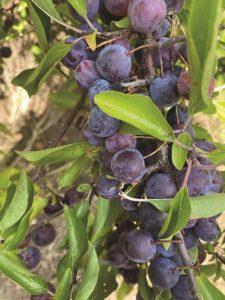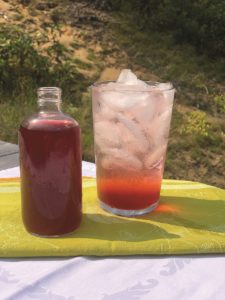People on the Outer Cape can be secretive about their go-to stands of beach plum. But not this year — one of abundance for the wild shrubs named Prunus maritima by Europeans in 1875. Last week, as the fruit ripened, signs went up in Wellfleet: “Beach plums — free to pick” and “Don’t be shy, help yourself.” Appeals for recipes circulated.

We love our beach plums out here. It’s got to be partly because they show up in May, when the landscape is still winter-bleak, as white and pinkish puffs on jagged dark branches. And they’re the last of the summer fruits. Preserving them is a way of hanging on to a Cape Cod summer for one more year.
A proprietary feeling shows up, too, when you have access to a plant that defies domestication. With the beach plum, that’s been tried many times. Even Luther Burbank couldn’t make it happen, according to beach plum scholar Richard H. Uva, writing in Arnoldia.
The unpredictable appearance of a big year for beach plums offers a kind of comfort we’re greedy for: here we have a bearer of fruit that sends taproots down into erosion-altered sands and doesn’t mind salt-air-filled windstorms or drought. No matter that they’re too tart to eat raw; they’re great smelted with sugar into jam or into a shrub as a tonic — or a cocktail.
Mark Bartley at Cape Abilities Farm in Dennis thinks there are two reasons this is a boom year for beach plums all over the Cape. First, we had a warm spring with none of the late freezes that sometimes get the blossoms of early-flowering fruit trees. And, in spite of some rain, we’re still in a drought, which can push trees to fruit more, for a time, anyway.
So, let’s stay on task, people — there are a lot of beach plums out there that need attention right now.

My food writer friend Katherine Alford made jam after coming across those “don’t be shy” signs. She says her favorite recipe is adapted from Yankee magazine. It includes a note of red wine. She agrees with their no-pectin approach — the fruit has plenty, and the softer set is lovely. Her version, though, reduces the sugar a tad. It’s a jam, not a jelly, so the fruit adds body.
For shrub, I use cider vinegar, but you could use a good wine vinegar. I prefer a cold-process method to preserve the bright flavor of the ripe fruit.
Speaking of which, use only the ripest beach plums to make your jam or your shrub — they should be fat and juicy. Rinse them and pick them over, removing stems and leaves. They may be mottled and uneven in color — it doesn’t matter what they look like. This isn’t a beauty contest — it’s a race against time to bottle a little bit of summer.

Katherine’s Beach Plum Jam
Editor’s note: The amount of plums in this recipe, which was wrong in the print version of this article, has been corrected below.
Makes 4 half-pint jars
4 heaping cups ripe beach plums
3½ cups sugar
1 cup red wine
Combine the plums, sugar, and wine in a 6-quart heavy-bottomed pot.
Bring to a simmer over low heat until the sugar dissolves and the plums release their juices. Carefully increase heat and let the mixture bubble gently, about 5 more minutes, until the fruit is soft.
Stick a small plate in the freezer to chill — you’ll use this to test the jam’s doneness.

Pour the mixture into a strainer set over a bowl, and press on the fruit to extract both juice and fruit pulp.
Return the juice and pulp to the pot and simmer, stirring often and scooping off foam as it rises to the top.
Manage the heat. You want the jam to bubble and reduce, but not to boil over. It should take about 20 to 30 minutes.
Test jam by dropping a spoonful onto a chilled plate. It should thicken when it hits the cold plate and seem to turn gelatinous. If it doesn’t, return the plate to the freezer and continue cooking the puree for 5 more minutes until it does test correctly.
Pour into hot, sterilized jars to within ¼ inch of the top, adjust lids, and set aside undisturbed to cool and seal.
Edouard’s Beach Plum Shrub
One quart jar of syrup
1 heaping quart very ripe beach plums
3½ cups sugar
3½ cups apple cider vinegar
Lightly crush the plums in a large bowl, using your hands, and toss well with the sugar. Cover the bowl and stash it in the refrigerator overnight.

When you retrieve the mix, the berries will be surrounded with ruby syrup. Pour the mixture through a sturdy colander to strain the solids, pressing on them to get out every last drop of juice (again, hands come in handy), and scrape any remaining sugar solids into the syrup.
Add the vinegar to the syrup and whisk it all together until the sugar is completely dissolved. Pour into a bottle or jar — quart canning jars work well — and refrigerate, allowing the processes of naturally occurring yeasts to do their thing. That is, the shrub may be used immediately but you’ll notice it improves with age: the sweetness and the tartness will remain, but they will mellow and become richer and more balanced over time.
To use the shrub, stir a couple of tablespoons into a glass of sparkling water for a quick, refreshing soft drink.
The cocktail options are endless, but I like one that reminds me of a drink we tasted on a lazy afternoon on the Mediterranean coast of Spain (to be perfectly honest, I can’t remember exactly where). Mix about two ounces of sherry with a splash of shrub (just a teaspoon or two) and stir into a glass of sparkling water.



